If you’re after a beautiful, easy-going, and hard-working horse, let me introduce you to the Haflinger. This compact yet strong breed is friendly, versatile, and always eager to please—whether on trails, in therapy programs, or pulling a carriage. I’ve worked with Haflingers for years, and their calm temperament and golden charm never disappoint. With that light gold coat and signature flaxen mane, it’s no wonder they’re winning hearts everywhere.
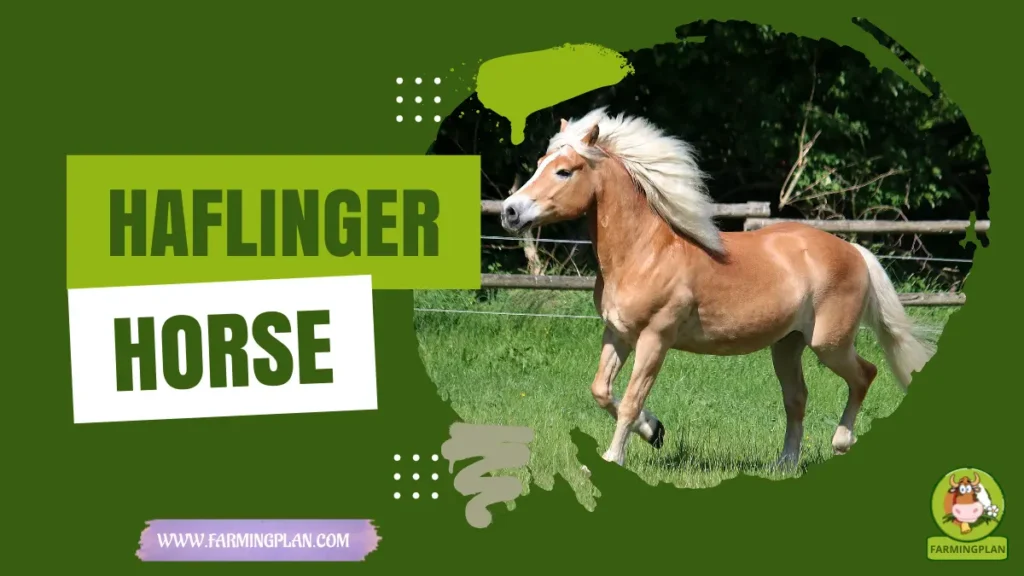
History & Origin of Haflinger Horse
Haflinger horse breed began in the late 19th century, nestled in the rugged and scenic South Tyrol region of what is now Austria and northern Italy. Back then, farmers needed a sturdy, compact horse for mountainous terrain that could carry loads, pull carts, and be easy to manage. That’s when the foundation stallion, a half-Arabian named Folie, stepped into the picture. Crossed with strong Tyrolean mares, he became the cornerstone of the Haflinger bloodline.
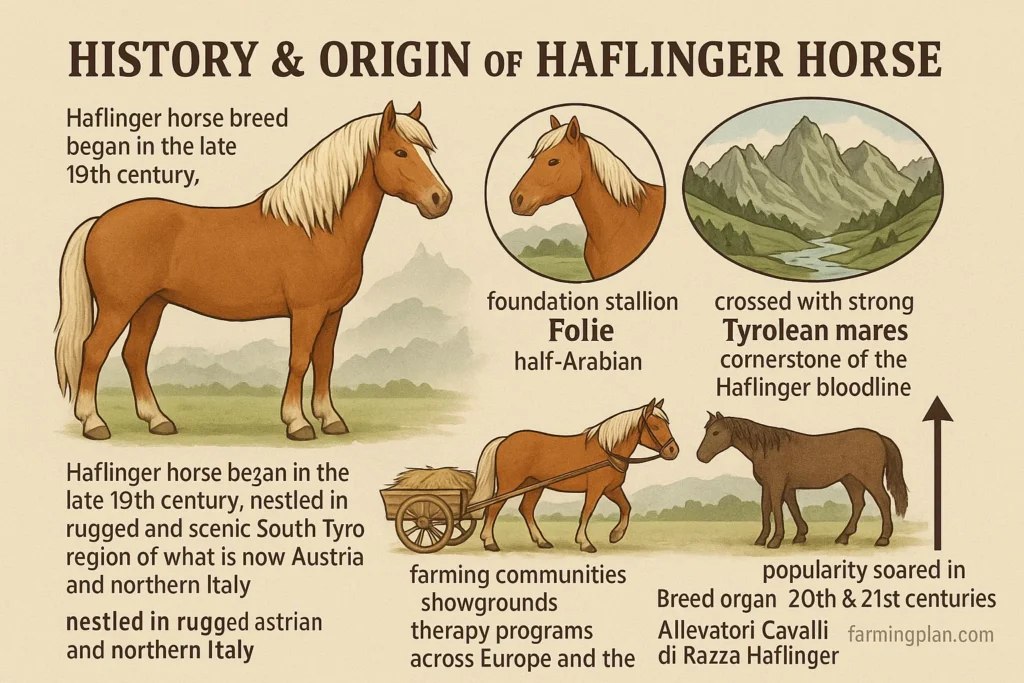
As time passed, this horse made its mark far beyond the Alps. With their dependable nature and distinctive look, Haflinger horse found a place in farming communities, showgrounds, and therapy programs across Europe and, eventually, the world. The breed’s popularity soared in the 20th and 21st centuries, especially with help from breed organizations like the Haflinger horse Breeding Association and Italy’s Allevatori Cavalli di Razza Haflinger Italia.
Breed Characteristics of Haflinger Horse
Haflinger horse might be small, but they’re mighty. On average, they stand between 13.2 and 15 hands tall. They’re sturdy and muscular but still have that graceful, athletic appearance that turns heads. Their coats usually shine in a rich, light gold color, paired with a cream or white-colored mane and tail that feels like silk.
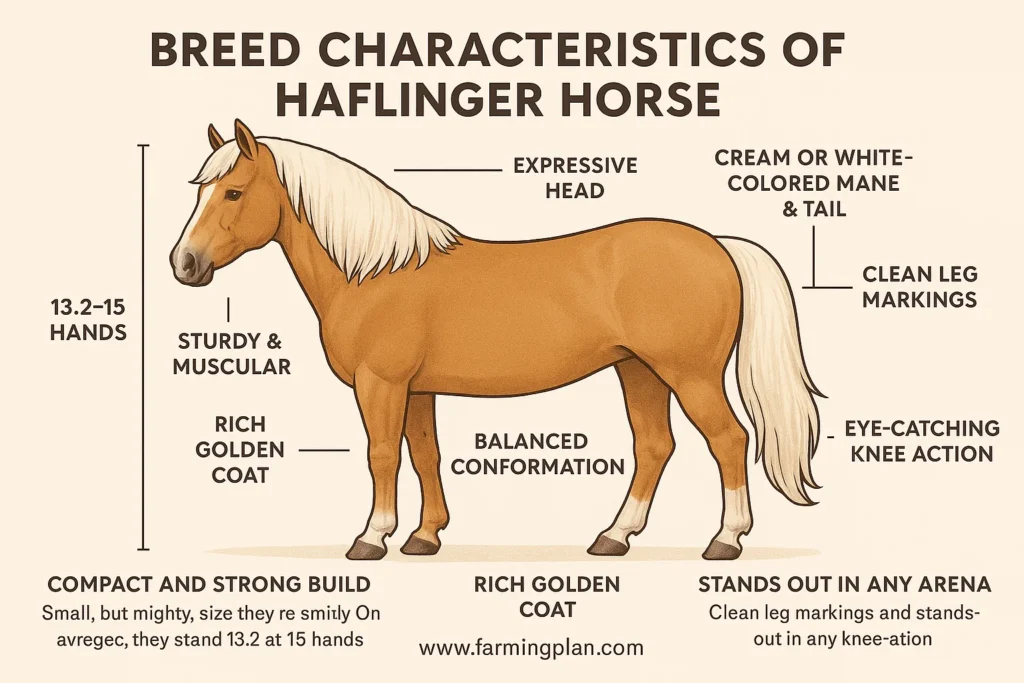
One of my favorite things about this breed is its expressive head and balanced conformation. Their legs often feature clean leg markings, and they move with an eye-catching knee action that makes them stand out in any arena. They’re compact, with strong backs and a solid build—perfect for both work and play.
Personality & Temperament of Haflinger Horse
You won’t meet many horses more agreeable than the Haflinger horse. They have a calm temperament that makes them excellent for beginners and experienced riders. Over the years, I’ve found them to be cooperative, willing learners, and intensely loyal. They’re never hot-headed or jumpy. This breed shines in therapeutic riding programs thanks to its gentle nature and steady pace. Haflinger horse enjoy human interaction and are very social—great for families, farms, and kids just learning to ride. They’re patient but responsive, so I always recommend them as a go-to breed for anyone new to horses.
Read more: American Cream Draft Horse: The Surprising Power Behind This Majestic Breed
Food & Diet of Haflinger Horse
Feeding a Haflinger isn’t complicated, but it does require some mindfulness. These horses have an efficient metabolism, which means they can gain weight quickly if you’re not careful. A diet mainly of high-quality hay and fresh pasture works best. I always ensure mine has access to clean water and a salt or mineral block. Avoid overloading them with grains or sugary treats. While they might love a carrot or apple, moderation is key. In colder months or during intense work periods, I add a bit of grain to their feed, but only under close monitoring. Haflingers stay healthiest on a simple and consistent diet.
Purpose & Uses of Haflinger Horse
Haflinger horse are one of the most versatile breeds I’ve worked with. They excel as pleasure riding horses, carriage horses, and even in dressage and endurance events. Their sure-footedness makes them amazing for trail riding, especially in hilly or uneven terrain. Beyond the show ring, they’re also farm favorites.
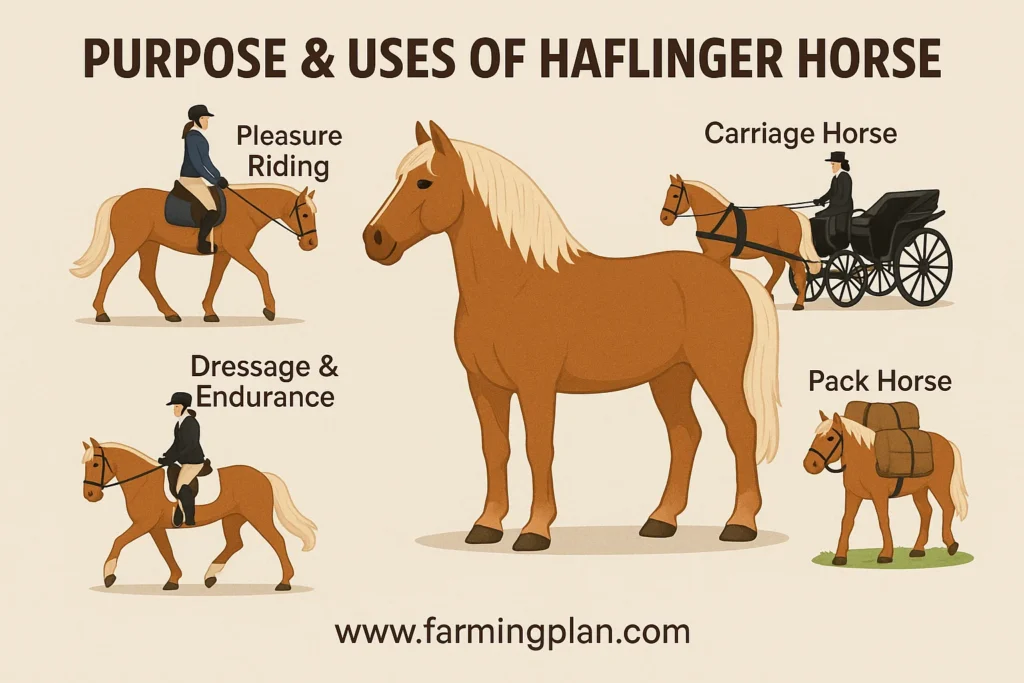
Historically used as pack horses in mountainous regions, their strength and stamina are still appreciated today. Whether you want a family horse, a competitive show partner, or a dependable worker on the homestead, the Haflinger checks all the boxes.
Special Features of Haflinger Horse
Let’s talk about what sets this breed apart. Their creamy white manes and tails paired with golden coats give them a look you won’t find anywhere else. That “desirable appearance” isn’t just for show; it’s part of their breed standard and breeding objectives. They’ve got excellent character, strong maternal and stallion lines, and dominate many European champion competitions. And unlike some breeds, Haflinger horse are relatively low-maintenance. Their adaptability and resilience make them a favorite among breeders aiming for dynamic, all-around performance in a compact package.
Health & Wellness of haflinger horse
Most Haflinger horse live long, healthy lives. But just like horses, they need proper care to avoid common problems. Obesity is one of the most frequent concerns due to their easy-keeping nature. If they get too heavy, they can develop laminitis or joint stress.
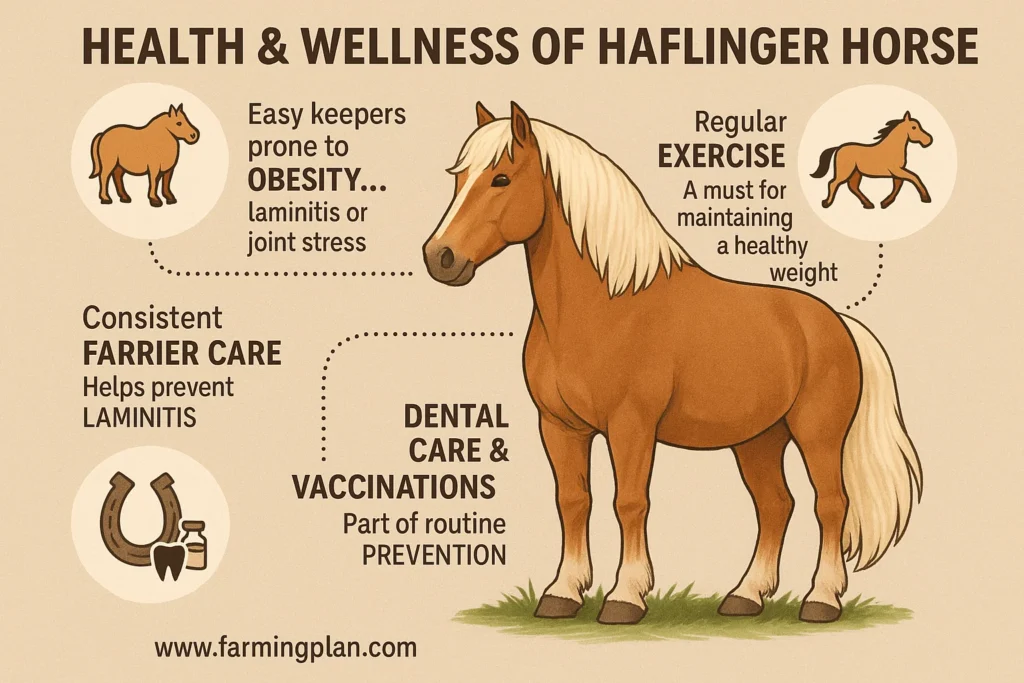
Regular exercise, a balanced diet, and consistent farrier care keep them in tip-top shape. I always tell new owners to watch out for subtle signs—warm hooves, stiffness, or off behavior. Routine dental care and vaccinations are non-negotiable. Healthy Haflingers are happy Haflinger horse, and prevention goes a long way.
Read more: Clydesdale Horse: The Gentle Giants of the Equine World
Step-by-Step Pet Owner Care Guide
Taking care of a Haflinger horse doesn’t have to be complicated—but it does take consistency, love, and a little know-how. This step-by-step guide breaks down everything you need to create a safe, happy, and healthy life for your Haflinger horse, whether a new owner or a seasoned equine enthusiast.
Step 1: Set Up a Safe & Comfortable Living Space
First things first—your Haflinger horse needs a place to feel safe, secure, and free to be its golden, charming self. Start by setting up a large, fenced-in pasture or paddock. These horses are curious and clever, so invest in strong, visible fencing like wood post-and-rail or electric tape. Avoid barbed wire at all costs—it’s a recipe for injury. Ensure there’s adequate shelter, whether it’s a run-in shed or a full barn stall. In warmer months, shade and breeze are essential. In colder climates, sound insulation and dry bedding are a must. Inside the stall or shelter, keep it clean and comfy with soft straw or shavings.
Don’t forget to organize feeding stations—messy hay piles just lead to waste and possible mold. Ventilation is key. A musty or poorly aired barn can lead to respiratory issues. And fresh, clean water should always be available, preferably from an insulated trough or heated bucket in winter. Haflinger horse are hardy but thrive when their living space is thoughtfully managed.
Step 2: Build a Balanced Feeding Routine
Feeding your Haflinger horse correctly is one of the most essential parts of care—and one of the easiest places to go wrong. These horses are “easy keepers,” meaning they maintain weight on less food than you’d think. They often need a basic diet of quality grass, hay, and pasture. I aim to achieve 1.5% to 2% of their weight daily during forage. During the winter or times of heavy work, I’ll mix in some low-starch grains or pelleted feed, but only if it’s genuinely needed. Too much rich feed can lead to obesity or colic. Keep a body condition score chart handy and adjust as needed.
Use a slow feeder hay net to help them nibble naturally instead of gobbling everything at once. Provide a free-choice salt block and consider a vitamin or mineral balancer if pasture quality is low. And yes—treats are okay in moderation! Carrots, apples, or a small handful of pellets make great rewards but don’t overdo it. Fresh, unfrozen water is non-negotiable, so check troughs or buckets daily, especially in extreme temperatures.
Step 3: Grooming & Mane Care That Builds Bonding
You can’t own a Haflinger and not fall in love with that flaxen mane. But it takes upkeep! Daily grooming isn’t just about looks—it’s a health check and bonding session. I start with a curry comb to loosen dirt, then use a soft body brush to bring out their natural shine. Their manes? Wide-tooth combs and detangling spray are your best friends. Pick out hooves daily to avoid thrush, abscesses, or stuck debris. Haflingers tend to be hardy, but that doesn’t mean you can skip hoof care. Look for signs of cracking, heat, or tenderness, and contact a farrier if something feels off.
Grooming is also a time to spot minor issues before they turn into big ones—like cuts, swelling, or ticks. And it’s an excellent moment for connection. Talk to your horse, hum a tune, or enjoy the quiet. These moments are where trust and friendship truly grow.
Step 4: Schedule Routine Health Checks & Farrier Visits
Don’t wait for something to go wrong—set your horse up for success with consistent health care. A reliable vet is your best ally. Work with them to establish a vaccine plan based on your region and risk factors. I vaccinate in spring and fall, then deworm according to fecal egg counts to avoid resistance. Equally important is dental care. Your Haflinger should have a dental check at least once a year. Sharp points or uneven wear can cause pain, weight loss, and behavior issues. Depending on hoof condition and workload, your farrier should visit every 6–8 weeks to trim or shoe.
Always trust your gut. If your horse seems off—maybe they’re not eating, acting lethargic, or just “off”—don’t wait. Call your vet. You’ll develop a sense of their normal rhythms, and that knowledge is priceless. A few proactive calls to your vet can save a lot of pain (and money) later.
Step 5: Provide Daily Exercise & Mental Enrichment
Haflingers love a job, and their brains are just as active as their bodies. That’s why daily movement and mental challenges are crucial. Turnout time is necessary—at least several hours a day in a pasture or paddock. To mix things up, add structured activities like groundwork, lunging, or trail riding. These horses also love learning! Mine can do basic liberty work and even a few fun tricks. You’d be surprised how much joy a Haflinger gets from mastering an obstacle course or playing with enrichment toys. They’re eager, responsive, and love working alongside their humans.
Vary their routine to keep things interesting. One day might be a trail ride; the next could be groundwork or a relaxing groom. Boredom is the enemy here. Keep their minds and bodies active, and you’ll have a happy, well-balanced horse ready for your next adventure together.
A Haflinger’s Golden Heart Shines Brighter Than Its Flaxen Mane—Strong, Steady, And Always Ready To Win Yours.
Expert Tips & Best Practices
- Always select breeding stock with strong maternal lines
- Avoid color impurities—these affect both appearance and registration
- “Always check for faults in mares before breeding. Quality starts with the dam.”
- Maintain regular hoof trimming to support strong conformation
- Don’t overfeed even if they beg—easy keepers need balanced diets
- Join a breed organization like the Haflinger Breeding Association for resources
- Use crossbreeding data and generation records (5th, 6th, 7th) to make informed decisions
Read more: The Majestic Shire Horse: A Gentle Giant with a Rich History
FAQ
Are Haflinger horses suitable for beginners?
Yes! Their calm, friendly temperament makes them ideal for new riders and families.
What is the average size of a Haflinger horse?
They typically stand between 13.2 to 15 hands high—perfect for kids and adults.
Can Haflingers be used in shows or dressage?
Absolutely. They compete in dressage, driving events, and even endurance competitions.
What do Haflinger horses eat?
Mainly hay and pasture grass. Keep grains limited and watch for weight gain.
Are Haflinger horses expensive to maintain?
Not particularly. They’re hardy, low-maintenance, and easy keepers with fewer health issues than some breeds.
Conclusion
The Haflinger horse is truly the whole package—beautiful, smart, strong, and incredibly kind. Whether you’re riding trails, competing, or just enjoying barn time, Haflingers bring a calm, dependable energy that’s hard to beat. With their golden coats and flaxen manes, they’re real showstoppers. I’ve raised and worked with Haflingers for years, and they never stop impressing me. Compact but powerful, sweet yet willing, they’re perfect for riders, breeders, or anyone who simply loves a good-hearted horse.
